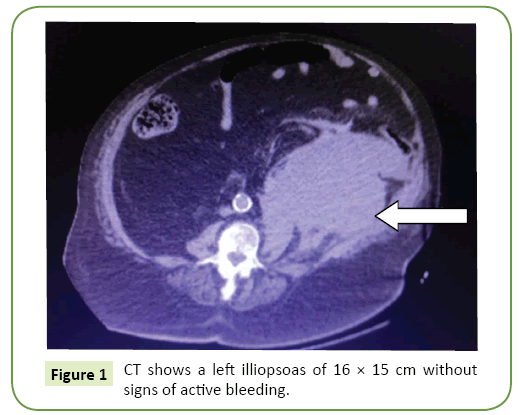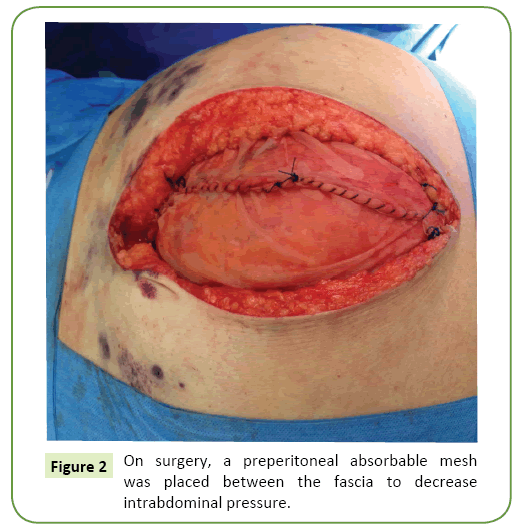Is Warfarin Safe in Elderly Patients? Illiopsoas Hematoma Leading to Abdominal Compartment Syndrome Caused by Warfarin
Minaya-Bravo AM1*, Mendoza-Moreno F1, Aguado-López H2, Hernández-Juara P1, Garcia-Mahillo JC3, Díez-Alonso MM1 and Noguerales-Fraguas F4
1General and Digestive Surgery Department. General and Digestive Surgeon.Principe de Asturias Teaching Hospital. Alcala de Henares. Madrid, Spain.
2General and Digestive Surgery Department. Resident of General and Digestive Surgery. Principe de Asturias Teaching Hospital. Alcala de Henares. Madrid, Spain.
4General and Digestive Surgery Department. Professor of General and Digestive Surgery Principe de Asturias Teaching Hospital. Alcala de Henares. Madrid, Spain.
- *Corresponding Author:
- Ana María Minaya-Bravo
Teaching Hospital, Alcalá de Henares
Madrid, Spain
Tel: 0034918878100
E-mail: ana-minaya@hotmail.com
Received Date: December 26, 2017; Accepted Date: January 10, 2018; Published Date: January 20, 2018
Citation: Minaya-Bravo AM, Mendoza-Moreno F, Aguado-López H, Hernández-Juara P, Garcia-Mahillo JC, et al. (2018) Is Warfarin Safe in Elderly Patients? Illiopsoas Hematoma Leading to Abdominal Compartment Syndrome Caused by Warfarin. Gen Surg Rep. Vol.2 No.1:2
Abstract
In the recent years, the increase of global life expectancy and atrial fibrillation has caused an growth in the number of elderly patients under anticoagulant therapy. The use of warfarin in elderly individuals is motive for concern because of the high risk of bleeding. Bleeding consequences can cause death. In addition, the patients with higher risk of bleeding are those that will benefit the most from anticoagulant therapy. We report a case of illiopsoas hematoma that caused an abdominal compartment syndrome and finally death. We report a 83-year-old male who was under anticoagulant therapy and suffered from bleeding causing an illiopsoas hematoma that eventually produced an abdominal compartment syndrome. He underwent surgery because of abdominal compartment syndrome but , finally, passed away because of pulmonary and renal complications. The use of anticoagulant in elderly can lead to death. A careful monitoring of dose is mandatory in order to avoid fatal consequences. For this purpose, different scores have been reported to help the physician to estimate benefits and risks. On this paper we also report a case of abdominal compartment syndrome caused by retroperitoneal hematoma. The treatment of illipsoas hematomas is based on discontinuation of anticoagulant and restoration of the circulating volume. In some occasions embolization could be required. However, retroperitoneal hematomas can cause other complications as abdominal compartment syndrome that also could need surgery. The physician must be take into account the fatal consequences of anticoagulant therapy in elderly patients. There are different scores designed to help to evaluate benefit and risk of bleeding. Bleeding can produce retroperitoneal hematoma that can lead to death because of bleeding, abdominal compartment syndrome and other underlying circumstances
Keywords
Illipoas; Warfarin; Retroperitoneal; Bleeding; Abdominal compartment syndrome
Introduction
Warfarin is widely used for the prevention of thromboembolic events and also for treatment of processes as atrial fibrillation. Atrial fibrillation constitutes a significant problem in elderly. The increase of expectancy of life and the growing incidence of atrial fibrillation have caused a high number of patients in their 70s, 80s and even 90s taking warfarin. It is estimated that 0.5% of the world population suffers from atrial fibrillation [1]. The right use of warfarin implies to achieve an international normalized ratio (INR) of 2.0 to 3.0 [2]. Bleeding is a serious complication in patients under anticoagulant therapy. Moreover, elderly individuals are a high risk group for bleeding. Bleeding consequences can produce death when they affect retroperitoneal or intracranial structures. Again the mortality rate on this situation is higher in elderly individuals because of comorbidity and pathophysiological considerations [3]. As a result, the use of anticoagulant therapy in elderly patients is challenging and requires a comprehensive analysis of benefits and risks as well as to avoid over or under treatment. Retroperitoneal hematoma affecting psoas and iliacus muscle is a serious complication of warfarin therapy. We report a case of illiopsoas hematoma occurring in an elderly patient under warfarin therapy that caused an abdominal compartment syndrome and needed surgery to decompress the abdomen. We also discuss the risk of bleeding in elderly patient under anticoagulant therapy.
Case Presentation
An 83-year-old Caucasian man patient was admitted to Emergency Department with abdominal pain and diaphoresis. He had suffered from pneumonia 2 weeks ago. His past medical history revealed atrial fibrillation, arterial hypertension chronic obstructive pulmonary disease and stroke. He was receiving 1.5 mg of warfarin per day, diltiazem 120 mg twice per day, ranitidine 300 mg per day, amiodarona 200 mg per day, tiotropium bromide and budesonide and formoterol inhaler. Also he needed oxygen therapy at home. The compliance was good.
On admission, he was anxious and pale. Blood pressure was 108 bpm, blood pressure 105/80 and oxygen saturation 92%. He presented tenderness and palpable mass in the lower left side of the abdomen. Blood tests showed: hemoglobin 8.0 g/dL, hematocrit 32%, platelet 140.000/UL and INR 5.93.
Intravenous fluid replacement, correction of INR with octaplex and blood cell transfusion were started. The patient was moved to Intensive Care Unit where he was stabilized and then a completed tomography (CT) with intravenous contrast was performed. It revealed a 16 × 15 cm left illiopsoas hematoma with signs of venous bleeding (Figure 1). The patient remained stable after restoring of circulating volume and correction of INR (INR after octaplex 1.5). After 72 hours, he presented significant abdominal pain with increase of abdominal diameter and acute renal failure. Blood test showed hemoglobin 10.5 g/dL, INR 1.4 and creatinine 1.8 mg/dL. Intra-abdominal pressure of 18 mmHg that peaked 23 mmHg. A CT was performed and it showed a left illiopsoas hematoma without signs of active bleeding. Despite of decompression of abdomen with nasogastric and rectal tubes, the intra-abdominal pressure remained 23 mmHg and the patient underwent surgery.
The goal of the surgery was abdominal decompression. For this purpose, we performed a middle laparotomy and incised lineal Alba from xifoid appendix to pubis and placed a preperitoneal absorbable mesh as a bridge between both fascias (Figure 2). None action was done on the hematoma. Intra-abdominal pressure returned to normal values. Renal function improved and the patient remained in Intensive Care Unit because of his pulmonary and renal situation. Eventually, he passed away.
Discussion
It is estimated that 4-10% of patients under anticoagulant therapy will present hemorrhage [4-7]. Age itself is considered a risk factor of bleeding. Palareti et al. reported an increased incidence of bleeding in patients over 75 years when compared to those below 70 years [5]. Different bleeding scores have been developed (RIETE, HEMORR2HAGES scores), they estimate the risk of bleeding based on different variables: age, creatinine level, hemoglobin, platelet counts, obesity, hepatic disease, genetic factors etc. [3,6]. Our patient had a Riette score of 4. Furthermore, risk of bleeding peaks exponentially with INR values above 4.5, regardless age. This supports the important role of careful monitoring in order to avoid hemorrhage [3]. This is not easy in elderly patients because of co-morbid factors, co-treatments and the peculiar pharmacokinetic and pharmacodynamic on these patients.
It must be taken in mind that individuals at highest risk of bleeding are often those that would have the most benefit from anticoagulant therapy. On the other hand, it is estimated that in USA only two thirds of all patients with atrial fibrillation have a INR in therapeutic range, so other factors may influence for bleeding complications [2]. Recently, it has been reported that the new oral anticoagulants have a lower risk of bleeding when compared to warfarin [8,9]. Illiopsoas hematoma is a rare complication of anticoagulant therapy, only isolated cases or small series have been published. Illiopsoas hematoma can produce symptoms of compression of femoral nerve or lumbar plexus leading to neurological symptoms. This situation requires surgery. Abdominal compartment syndrome is also other consequence of illiopsoas hematoma that could need surgery. This presentation is rare and very few cases have been reported. Treatment of illiopsoas hematoma includes initially restoration of the circulating volumen, bed rest, anticoagulant discontinuation and correction of INR. When patient is hemodynamically unstable, embolization of arterial vessels or surgery must be considered.
Conclusion
Anticoagulant therapy in elderly is a challenge and can cause bleeding with fatal consequences. Many scores have been developed to help the physician to determine risks and benefits of oral anticoagulant therapy. It must be taken in mind that individuals at highest risk of bleeding are often those that would have the most benefit from anticoagulant therapy. A careful monitoring of INR is mandatory in these patients. New oral anticoagulants could be an option for those patients with a high risk of bleeding.
Conflicts of Interest
All authors declare no conflict of interest.
References
- Zubaid M, Saad H, Ridha M, Mohanan Nair KK, Rashed W, et al.(2013) Quality of anticoagulation with warfarin across Kuwait. Hellenic J Cardiol 54: 102-106.
- Pokorney SD, Simon DN, Thomas L, Fonarow GC, Kowey PR, et al. (2015) Patients’ time in therapeutic range on warfarin among US patients with atrial fibrillation: Results from ORBIT-AF registry. Am Heart J 170: 141-148.
- Robert-Ebadi H, Righini M (2010) Anticoagulation in the elderly. Pharmaceuticals 3: 3543-3569.
- Wysowski DK, Nourjah P, Swartz L (2007) Bleeding complications with warfarin use: a prevalent adverse effect resulting in regulatory action. Arch Intern Med 167:1414-1419.
- Palareti G, Hirsh J, Legnani C, Manotti C, D'Angelo A, et al. (2000) Oral anticoagulation treatment in the elderly: a nested, prospective, case-control study. Arch Intern Med 160: 470-478.
- Gage BF, Yan Y, Milligan PE, Waterman AD, Culverhouse R, et al. (2006) Clinical classification schemes for predicting hemorrhage: Results from the National Registry of Atrial Fibrillation (NRAF). Am Heart J 151:713-719.
- Wada Y, Yanagihara C, Nishimura Y (2005) Bilateral Iliopsoas hematomas complicating anticoagulant therapy. Intern Med 44:641-643.
- López-López JA, Sterne JAC, Thom HHZ, Higgins JPT, Hingorani AD, et al. (2017) Oral anticoagulants for prevention of stroke in atrial fibrillation: Systematic review, network meta-analysis, and cost effectiveness analysis. BMJ28: 359.
- Fernandes C, Pereira P, Rodrigues M (2015) Spontaneous iliopsoas muscle haematoma as a complication of anticoagulation in acute cerebral venous thrombosis: to stop or not to stop (the anticoagulation). BMJ Case Rep.
Open Access Journals
- Aquaculture & Veterinary Science
- Chemistry & Chemical Sciences
- Clinical Sciences
- Engineering
- General Science
- Genetics & Molecular Biology
- Health Care & Nursing
- Immunology & Microbiology
- Materials Science
- Mathematics & Physics
- Medical Sciences
- Neurology & Psychiatry
- Oncology & Cancer Science
- Pharmaceutical Sciences


